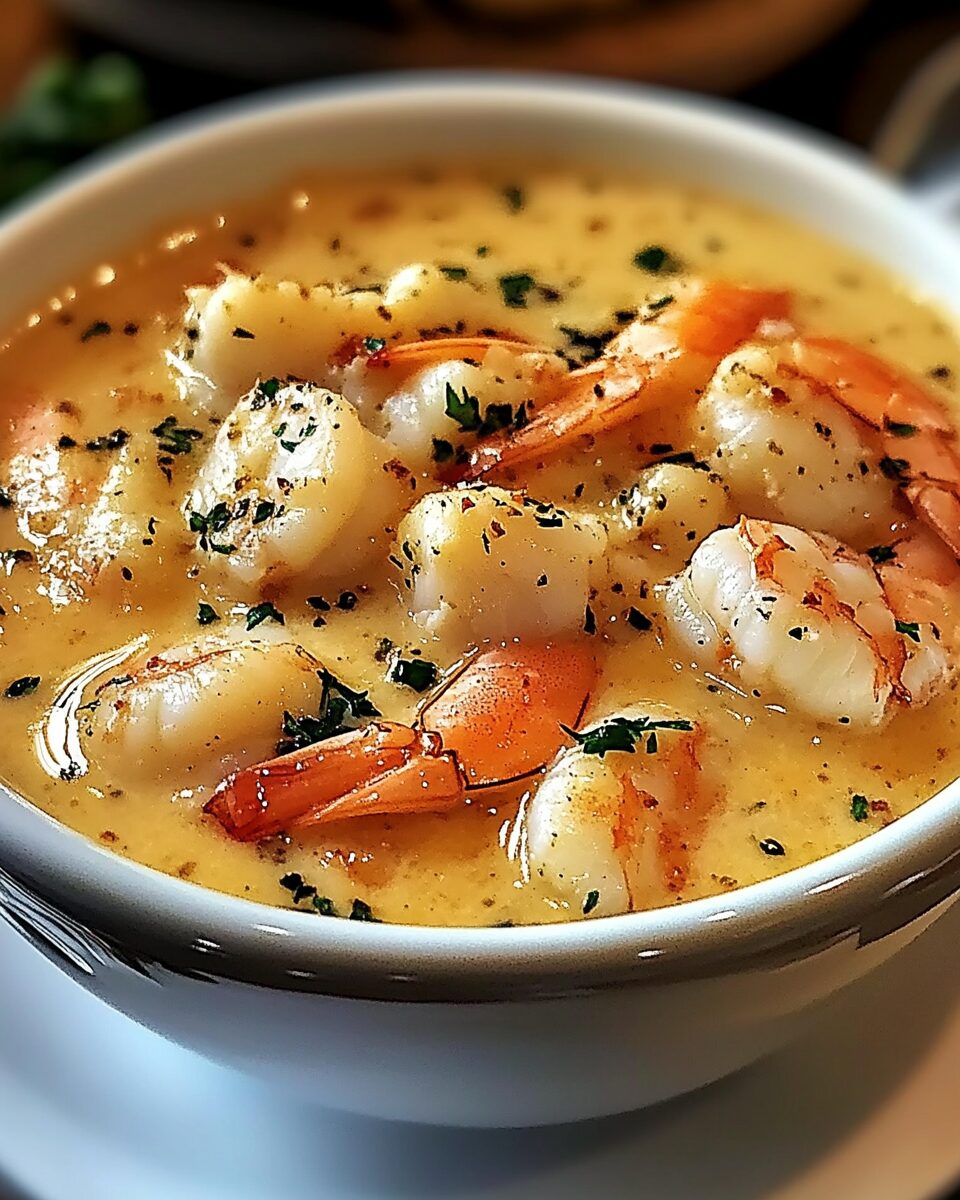This Crab and Shrimp Seafood Bisque is a decadent and creamy soup that’s perfect for impressing guests or enjoying a luxurious weeknight dinner. Packed with the rich flavors of fresh seafood and a hint of sherry, this dish is both elegant and comforting.
Full Recipe:
Ingredients
- 2 tablespoons butter
- 1 small onion, finely chopped
- 2 garlic cloves, minced
- 1/4 cup all-purpose flour
- 3 cups seafood or chicken stock
- 1 cup heavy cream
- 1/2 cup dry sherry
- 1 teaspoon Old Bay seasoning
- 1/4 teaspoon cayenne pepper (optional)
- 1/2 pound lump crabmeat
- 1/2 pound shrimp, peeled and deveined
- Salt and pepper, to taste
- Fresh chives or parsley, for garnish
Directions
- Melt the butter in a large pot over medium heat. Add the onion and garlic, cooking until softened.
- Stir in the flour and cook for 2 minutes, then slowly whisk in the seafood or chicken stock until smooth.
- Bring the mixture to a boil, then reduce the heat and simmer for 5 minutes.
- Stir in the heavy cream, sherry, Old Bay seasoning, and cayenne pepper, if using. Cook until the soup thickens slightly, about 10 minutes.
- Gently fold in the crabmeat and shrimp, allowing them to cook through for about 3–5 minutes. Season with salt and pepper to taste.
- Serve hot, garnished with chives or parsley.
Nutritional Facts (per serving):
- Calories: 280
- Protein: 16g
- Total Fat: 16g
- Saturated Fat: 10g
- Cholesterol: 120mg
- Carbohydrates: 10g
- Fiber: 0g
- Sugars: 1g
- Sodium: 820mg
Crab and Shrimp Seafood Bisque: A Luxurious Culinary Delight
Crab and Shrimp Seafood Bisque is the epitome of indulgent comfort food—elegant enough for a fine dining experience yet simple enough to prepare in your home kitchen. This creamy, flavorful soup is beloved for its rich texture and depth of taste, thanks to the natural sweetness of seafood, the velvety smoothness of cream, and the aromatic layers of herbs and spices. A bisque is not just another soup; it’s a celebration of French culinary finesse fused with coastal seafood traditions, making it an unforgettable dish for seafood lovers.
The History of Bisque: A Taste of French Culinary Heritage
To fully appreciate crab and shrimp seafood bisque, it’s important to understand its roots. The term “bisque” originates from French cuisine, referring to a smooth, creamy soup traditionally made from crustaceans like lobster, crab, or shrimp. Classic French bisques date back centuries and were often considered a delicacy served at aristocratic gatherings and elite banquets.
In its earliest form, bisque was made using ground shells and entire crustaceans to extract flavor. The technique involved simmering the shells to develop a deep stock, then pureeing the entire mixture to create a thick, velvety consistency. Over time, the recipe has evolved, especially in modern adaptations, which tend to be smoother, creamier, and easier to prepare without compromising on flavor.
The Marriage of Crab and Shrimp: A Perfect Pairing
Crab and shrimp complement each other exceptionally well in bisques. Crab meat brings a slightly sweet, delicate flavor that contrasts beautifully with the firm, savory, slightly briny notes of shrimp. Together, they create a multi-dimensional flavor profile that’s both comforting and luxurious.
Crab meat, particularly from blue crab or Dungeness varieties, provides a buttery mouthfeel, while shrimp adds a satisfying chew and robustness. These two ingredients, when combined in a bisque, create a harmony of texture and flavor that is hard to match with any other pairing.
Why Seafood Bisque Stands Out
While chowders and broths also have their place in seafood cuisine, bisque stands out for its elegant presentation and luxurious texture. What makes bisque particularly special is its emulsified base, typically made with cream or milk, butter, and sometimes a touch of wine or brandy. These elements elevate the soup, creating a silky smooth finish that makes every spoonful a rich experience.
Unlike broths, which are light and clear, or chowders, which are thick and chunky, bisque offers a refined, velvety mouthfeel. This makes it suitable for a romantic dinner, a festive holiday meal, or a sophisticated appetizer at a dinner party.
Flavor Layers and Aromatics: The Soul of the Bisque
One of the secrets to a remarkable seafood bisque lies in the careful layering of flavors. Starting with a base of sautéed aromatics like onions, garlic, celery, and sometimes carrots, the soup develops an umami-rich foundation. Herbs such as thyme, bay leaves, and parsley enhance the complexity, while a splash of dry sherry, white wine, or brandy deepens the overall flavor.
Texture and Creaminess: The Hallmarks of a Great Bisque
Texture plays a crucial role in distinguishing a good bisque from a great one. The cream or half-and-half adds the quintessential silkiness, but it’s the delicate process of blending and straining that results in a smooth, lump-free texture. Some variations use a roux (a mix of butter and flour) to thicken the bisque further, while others rely solely on the cream and pureed vegetables.
Nutrition Profile: Comfort Without Guilt
Though seafood bisque is often viewed as indulgent, it can also be relatively nutritious, especially when prepared with high-quality ingredients. Crab and shrimp are excellent sources of lean protein, omega-3 fatty acids, and essential minerals like zinc, iodine, and selenium.
Modern Twists and Regional Variations
The classic crab and shrimp seafood bisque has inspired many creative versions across different regions and cultures. In Cajun and Creole cooking, for instance, the bisque may be seasoned with a bolder mix of spices such as paprika, cayenne, and Cajun seasoning, giving it a more vibrant kick.
Presentation: Elevating the Dining Experience
Presentation is key when serving bisque. Traditionally, it is ladled into deep soup bowls or elegant cups and topped with a drizzle of cream, a sprinkle of fresh herbs, or a few whole pieces of crab or shrimp. A crusty baguette, garlic bread, or parmesan crostini served on the side adds the perfect crunchy contrast to the creamy soup.
Pairing Recommendations: Complementing the Flavors
A bisque as rich and flavorful as this pairs beautifully with both food and drink. For wines, a chilled Chardonnay or Sauvignon Blanc complements the creaminess while cutting through the richness. A light Pinot Grigio or even a sparkling wine can also work well to refresh the palate between bites.
Serving Occasions: From Weeknight Indulgence to Festive Feast
Crab and Shrimp Seafood Bisque is a versatile dish that fits a variety of dining settings. It can be served as a starter at an upscale dinner, as a main course for a cozy family gathering, or even as a signature item at a holiday feast.
Storage and Reheating Tips
If you have leftovers (though it’s rare with a dish this delicious!), seafood bisque stores well in the refrigerator for up to 3 days. Store it in an airtight container and reheat gently over low heat to prevent the cream from curdling. Avoid boiling the soup during reheating, as it can break the emulsion and alter the texture.
For longer storage, some cooks freeze the bisque before adding the cream. When ready to serve, the base can be thawed, reheated, and finished with fresh cream to restore its velvety texture.
Common Mistakes to Avoid
Even experienced cooks can encounter a few pitfalls when making seafood bisque. Here are a few things to keep in mind:
-
Overcooking the seafood: Shrimp and crab cook quickly. Overcooking can make them rubbery or dry.
-
Using low-quality seafood: The flavor of the bisque hinges on fresh, high-quality ingredients.
-
Skipping the straining step: A silky texture is what defines a bisque, so always strain if you’re blending solids.
-
Boiling the cream: This can cause separation and ruin the consistency.
-
Underseasoning: Seafood soups need robust seasoning to shine, so taste and adjust throughout the cooking process.
Conclusion: A Gourmet Bowl Worth Savoring
Crab and Shrimp Seafood Bisque is more than just a soup—it’s a gourmet experience in a bowl. From its French-inspired roots to its rich, layered flavors and luxurious texture, it’s a dish that exudes comfort and sophistication. Whether you’re preparing it for a romantic dinner, a holiday celebration, or simply to treat yourself after a long day, this bisque promises a deeply satisfying culinary journey.






